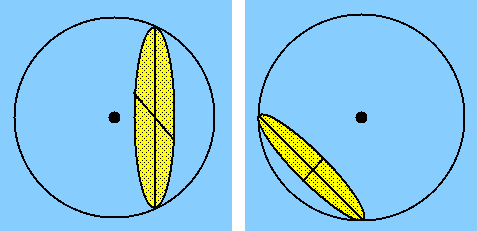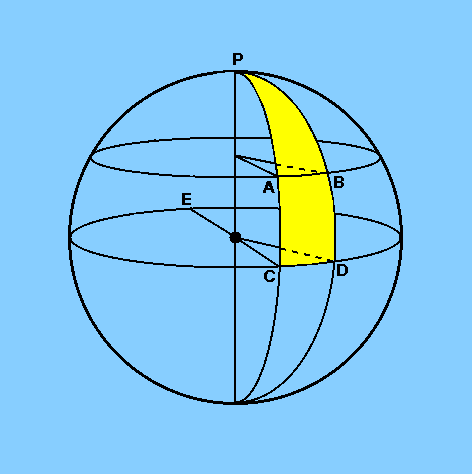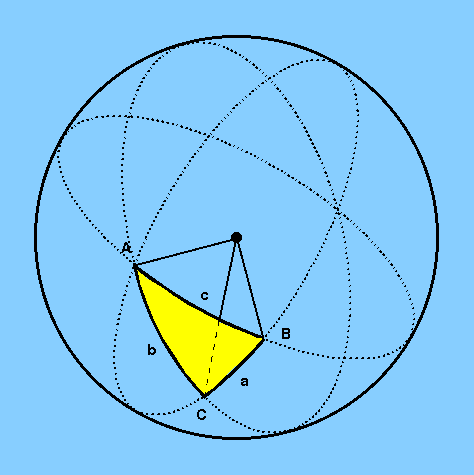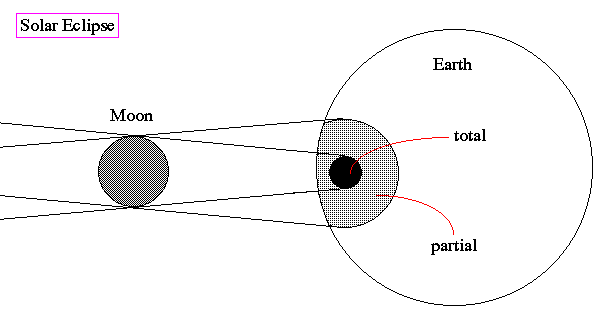
Two great circles
To explore the solar system, one first needs a coordinate system, a map. For getting around town, a flat map works fine with four directions, north, east, south, west. However, the sky appears to look like a sphere, so spherical coordinates are needed.
The shortest path between two points on a plane is a straight line. On the surface of a sphere, however, there are no straight lines. The shortest path between two points on the surface of a sphere is given by the arc of the great circle passing through the two points. A great circle is defined to be the intersection with a sphere of a plane containing the center of the sphere.

Two great circles
If the plane does not contain the center of the sphere, its intersection with the sphere is known as a small circle. In more everyday language, if we take an apple, assume it is a sphere, and cut it in half, we slice through a great circle. If we make a mistake, miss the center and hence cut the apple into two unequal parts, we will have sliced through a small circle.

Two small circles
Spherical Triangles:
If we wish to connect three points on a plane using the shortest possible route, we would draw straight lines and hence create a triangle. For a sphere, the shortest distance between two points is a great circle. By analogy, if we wish to connect three points on the surface of a sphere using the shortest possible route, we would draw arcs of great circles and hence create a spherical triangle. To avoid ambiguities, a triangle drawn on the surface of a sphere is only a spherical triangle if it has all of the following properties:

The figure below shows a spherical triangle, formed by three intersecting great circles, with arcs of length (a,b,c) and vertex angles of (A,B,C).

Note that the angle between two sides of a spherical triangle is defined as the angle between the tangents to the two great circle arcs, as shown in the figure below for vertex angle B.

Earth's Surface:
The rotation of the Earth on its axis presents us with an obvious means of defining a coordinate system for the surface of the Earth. The two points where the rotation axis meets the surface of the Earth are known as the north pole and the south pole and the great circle perpendicular to the rotation axis and lying half-way between the poles is known as the equator. Great circles which pass through the two poles are known as meridians and small circles which lie parallel to the equator are known as parallels or latitude lines.


The latitude of a point is the angular distance north or south of the equator, measured along the meridian passing through the point. A related term is the co-latitude, which is defined as the angular distance between a point and the closest pole as measured along the meridian passing through the point. In other words, co-latitude = 90° - latitude.

Distance on the Earth's surface is usually measured in nautical miles, where one nautical mile is defined as the distance subtending an angle of one minute of arc at the Earth's center. A speed of one nautical mile per hour is known as one knot and is the unit in which the speed of a boat or an aircraft is usually measured.
Horizon System:
Humans perceive in Euclidean space -> straight lines and planes. But, when distances are not visible (i.e. very large) than the apparent shape that the mind draws is a sphere -> thus, we use a spherical coordinate system for mapping the sky with the additional advantage that we can project Earth reference points (i.e. North Pole, South Pole, equator) onto the sky. Note: the sky is not really a sphere!
From the Earth's surface we envision a hemisphere and mark the compass points on the horizon. The circle that passes through the south point, north point and the point directly over head (zenith) is called the meridian.

This system allows one to indicate any position in the sky by two reference points, the time from the meridian and the angle from the horizon. Of course, since the Earth rotates, your coordinates will change after a few minutes.
The horizontal coordinate system (commonly referred to as the alt-az system) is the simplest coordinate system as it is based on the observer's horizon. The celestial hemisphere viewed by an observer on the Earth is shown in the figure below. The great circle through the zenith Z and the north celestial pole P cuts the horizon NESYW at the north point (N) and the south point (S). The great circle WZE at right angles to the great circle NPZS cuts the horizon at the west point (W) and the east point (E). The arcs ZN, ZW, ZY, etc, are known as verticals.

The two numbers which specify the position of a star, X, in this system are the azimuth, A, and the altitude, a. The altitude of X is the angle measured along the vertical circle through X from the horizon at Y to X. It is measured in degrees. An often-used alternative to altitude is the zenith distance, z, of X, indicated by ZX. Clearly, z = 90 - a. Azimuth may be defined in a number of ways. For the purposes of this course, azimuth will be defined as the angle between the vertical through the north point and the vertical through the star at X, measured eastwards from the north point along the horizon from 0 to 360°. This definition applies to observers in both the northern and the southern hemispheres.

It is often useful to know how high a star is above the horizon and in what direction it can be found - this is the main advantage of the alt-az system. The main disadvantage of the alt-az system is that it is a local coordinate system - i.e. two observers at different points on the Earth's surface will measure different altitudes and azimuths for the same star at the same time. In addition, an observer will find that the star's alt-az coordinates changes with time as the celestial sphere appears to rotate. Despite these problems, most modern research telescopes use alt-az mounts, as shown in the figure above, owing to their lower cost and greater stability. This means that computer control systems which can transform alt-az coordinates to equatorial coordinates are required.
Celestial Sphere:
The celestial sphere has a north and south celestial pole as well as a celestial equator which are projected reference points to the same positions on the Earth surface. Right Ascension and Declination serve as an absolute coordinate system fixed on the sky, rather than a relative system like the zenith/horizon system. Right Ascension is the equivalent of longitude, only measured in hours, minutes and seconds (since the Earth rotates in the same units). Declination is the equivalent of latitude measured in degrees from the celestial equator (0 to 90). Any point of the celestial (i.e. the position of a star or planet) can be referenced with a unique Right Ascension and Declination.

The celestial sphere has a north and south celestial pole as well as a celestial equator which are projected from reference points from the Earth surface. Since the Earth turns on its axis once every 24 hours, the stars trace arcs through the sky parallel to the celestial equator. The appearance of this motion will vary depending on where you are located on the Earth's surface.

Note that the daily rotation of the Earth causes each star and planet to make a daily circular path around the north celestial pole referred to as the diurnal motion.

Equatorial Coordinate System :
Because the altitude and azimuth of a star are constantly changing, it is not possible to use the horizontal coordinate system in a catalog of positions. A more convenient coordinate system for cataloging purposes is one based on the celestial equator and the celestial poles and defined in a similar manner to latitude and longitude on the surface of the Earth. In this system, known as the equatorial coordinate system, the analog of latitude is the declination, δ. The declination of a star is its angular distance in degrees measured from the celestial equator along the meridian through the star. It is measured north and south of the celestial equator and ranges from 0° at the celestial equator to 90° at the celestial poles, being taken to be positive when north of the celestial equator and negative when south. In the figure below, the declination of the star X is given by the angle between Y and X.

The analog of longitude in the equatorial system is the hour angle, H (you may also see the symbol HA used). Defining the observer's meridian as the arc of the great circle which passes from the north celestial pole through the zenith to the south celestial pole, the hour angle of a star is measured from the observer's meridian westwards (for both northern and southern hemisphere observers) to the meridian through the star (from 0° to 360°). Because of the rotation of the Earth, hour angle increases uniformly with time, going from 0° to 360° in 24 hours. The hour angle of a particular object is therefore a measure of the time since it crossed the observer's meridian - hence the name. For this reason it is often measured in hours, minutes and seconds of time rather than in angular measure (just like longitude). In figure above, the hour angle of the star X is given by the angle Z-NCP-X. Note that all stars attain their maximum altitude above the horizon when they transit (or attain upper culmination on, in the case of circumpolar stars) the observers meridian.
The declination of a star does not change with time. The hour angle does, and hence it is not a suitable coordinate for a catalogue. This problem is overcome in a manner analogous to the way in which the Greenwich meridian has been (arbitrarily) selected as the zero point for the measurement of longitude. The zero point chosen on the celestial sphere is the first point of Aries, γ, and the angle between it and the intersection of the meridian through a celestial object and the celestial equator is called the right ascension (RA) of the object. Right ascension is sometimes denoted by the Greek letter α and is measured from 0h to 24h along the celestial equator eastwards (in the direction of a right-handed screw motion about the direction to the north celestial pole) from the first point of Aries, that is, in the opposite direction to that in which hour angle is measured. Like the definition of hour angle, this convention holds for observers in both northern and southern hemispheres. In above figure, the right ascension of the star X is given by the angle -NCP-Y.

Most modern research telescopes do not use equatorial mounts due to their higher cost and lower stability. This is at the expense of the simplicity of telescope tracking - an equatorially-mounted telescope need only move its right ascension axis in order to track the motion of the celestial sphere. The figure above shows an example of an equatorially-mounted telescope.

Constellations:
Drawn onto the celestial sphere are imaginary shapes called constellations, Latin for `group of stars'. Due to the nature of the Earth's surface, the sky is divided into the northern and southern sky as seen from each hemisphere.



The origin of the names of particular constellations is lost with time, dating back before written records. The ancient Greeks were the first to record the oral legends. But the boundaries of the constellations were fixed by the International Astronomical Union in 1928. For many of the constellations it is easy to see where they got their names. For example,




In all, there are 88 constellation names cataloged by Hipparchus in 100 B.C. To find out more about your favorite constellation, goto Constellation of the Month. Since the boundaries are fixed, a star will always remain in a constellation unless its proper motion moves it into another.
Star Names:
Hipparchus also developed a simply method of identifying the stars in the sky by using a letter from the Greek alphabet combined with the constellation name.

So, for example, the brightest star in the constellation Orion is Alpha Orion, the second brightest star is Beta Orion, and so on. When the letters run out, we use a number 33 Orion, 101 Orion, etc. Some of the very brightest stars have their own names due to their importance to early navigators. For example, Alpha Canis Major is Sirius, the Dog Star.


About 6000 stars are visible with the naked eye on a dark, moonless night. However, there are over 1013 stars in the whole Milky Way galaxy were the solar system resides. Thus, we only see a very small fraction of the closest and brightest stars with our eyes. The first star catalog was published by Ptolemy in the 2nd century. It contained the positions of 1025 of the brightest stars in the sky. The first modern star catalog was the Bonner Durchmusterung by Argelander in 1860, containing 320,000 stars.

Since the Earth's axis is tilted 23 1/2 degrees from the plane of our orbit around the Sun, The apparent motion of the Sun through the sky during the year is a circle that is inclined 23 1/2 degrees from the celestial equator. This circle is called the ecliptic and passes through 12 of the 88 constellations that we call the zodiac.

Equinox and Solstice:
The projection of the Sun's path across the sky during the year is called the ecliptic. The points where the ecliptic crosses the celestial equator are the vernal and autumnal equinox's. The point were the Sun is highest in the northern hemisphere is called the summer solstice. The lowest point is the winter solstice.

Days are longest in the summer for the northern hemisphere due to tilt of the Earth's axis allowing for more sunlight to be projected onto surface. Note also the reason for the "midnight" sun at the North Pole in summer. Longest day of the year is at the summer solstice

For opposite reasons, days are short and nights long in the winter.

Seasons:
 The seasons are caused by the angle the sun's rays make with the ground.
Higher Sun angle means more luminosity per square meter. Low Sun angle
produces fewer rays per square meter. More intensity means more heat and,
therefore, higher temperatures.
The seasons are caused by the angle the sun's rays make with the ground.
Higher Sun angle means more luminosity per square meter. Low Sun angle
produces fewer rays per square meter. More intensity means more heat and,
therefore, higher temperatures.
Note that, due to the fact that our oceans store heat, the actual changes in mean Earth temperature are delayed by several weeks, i.e. the hottest days of summer are usually in late July, over a month from the summer solstice.
Sidereal and Synodic time:
A `day' is defined by the rotation of object in question. For example, the Moon's `day' is 27 Earth days.
A `year' is defined by the revolution of object in question. For example, the Earth's year is 365 days divided into months; whereas, Pluto's `year' is 248.6 Earth years.
Typical we use synodic time, which means with respect to the Sun, in our everyday life. For example, noon, midnight, twilight are all examples of synodic time based on where the Sun is in the sky (e.g. directly overhead on the equator for noon). Astronomers often use sidereal time, which means time with respect to the stars, for their measurements.
Since the Earth moves around the Sun once every 365 days, the Sun's apparent position in the sky changes from day to day.

Phases of the Moon:
The Moon is tidally locked to the Earth, meaning that one side always faces us (the nearside), whereas the farside is forever hidden from us. In addition, the Moon is illuminated on one side by the Sun, the other side is dark (night).
Which parts are illuminated (daytime) and which parts we see from the Earth are determined by the Moon's orbit around the Earth, what is called the phase of the Moon (click here for the current phase of the Moon).
As the Moon moves counterclockwise around the Earth, the daylight side becomes more and more visible (i.e. we say the Moon is `waxing'). After full Moon is reached we begin to see more and more of the nighttime side (i.e. we say the Moon is `waning'). This whole monthly sequence is called the phases of the Moon.


Eclipses:
On rare occasions the Moon comes between the Earth and the Sun (a solar eclipse) or the Moon enters the Earth's shadow (a lunar eclipse).




|
|

|